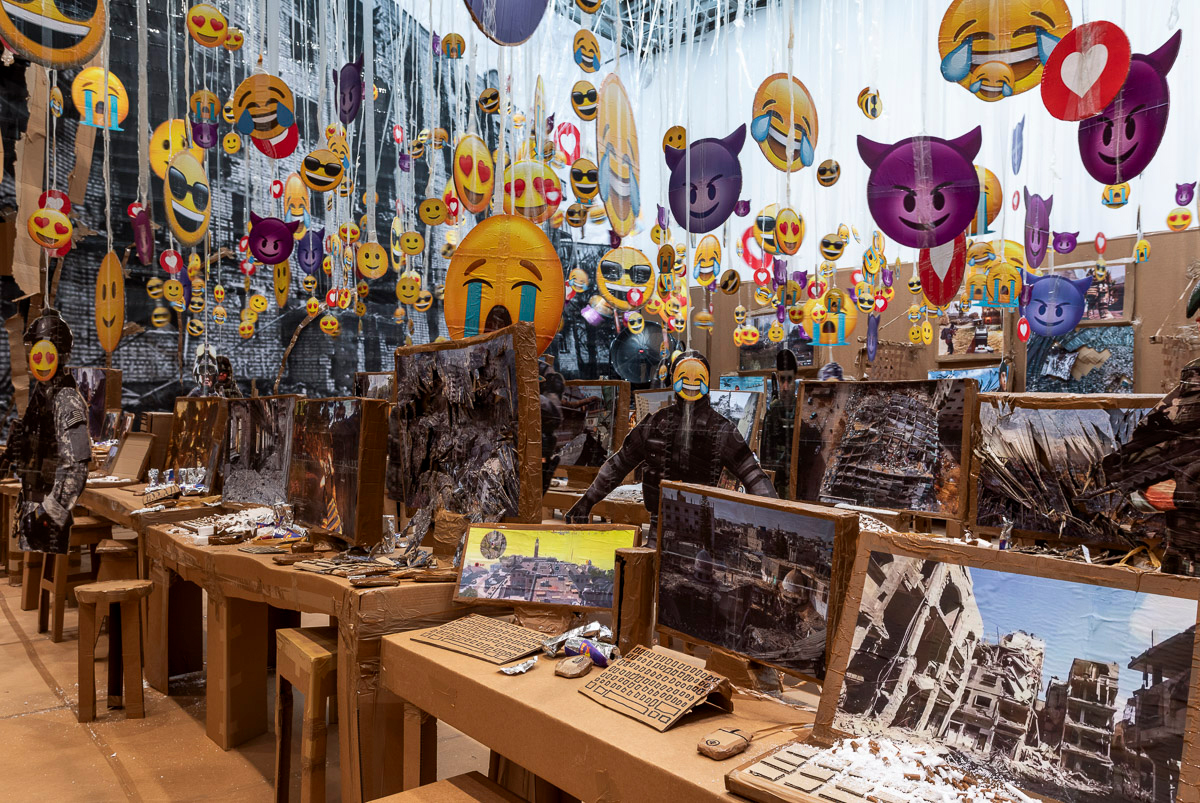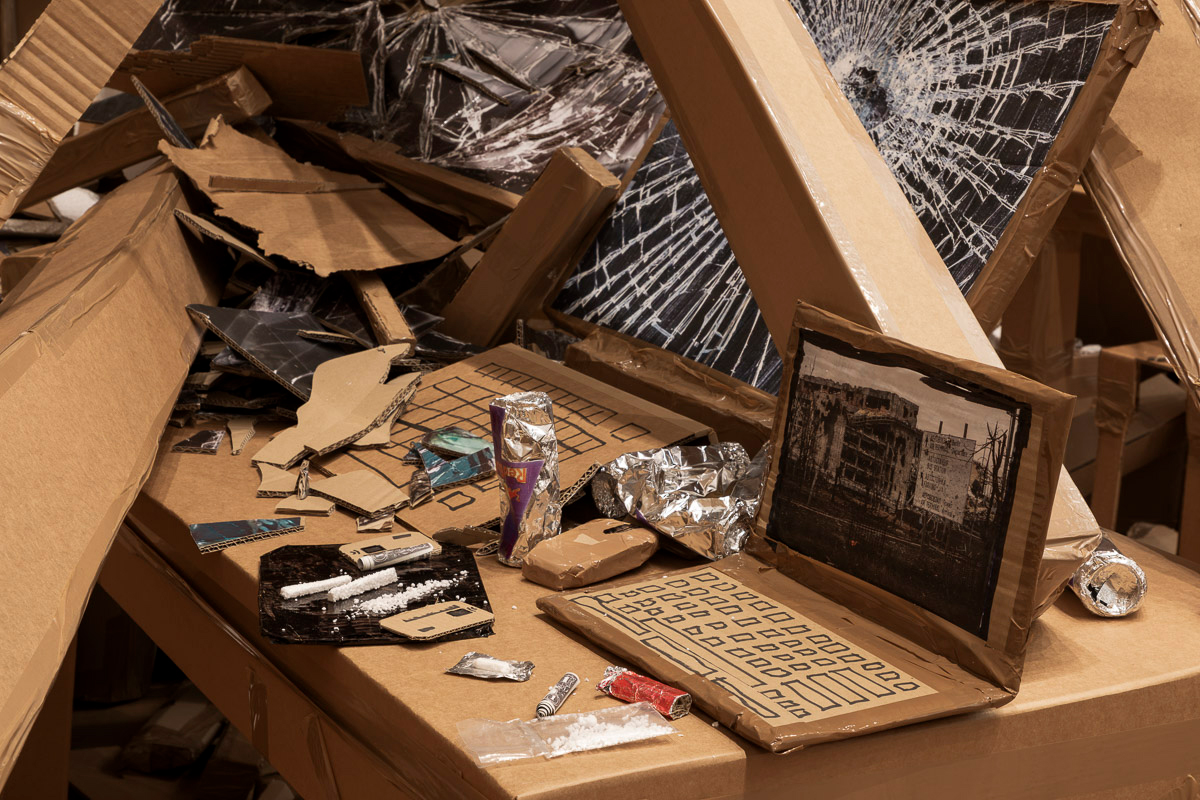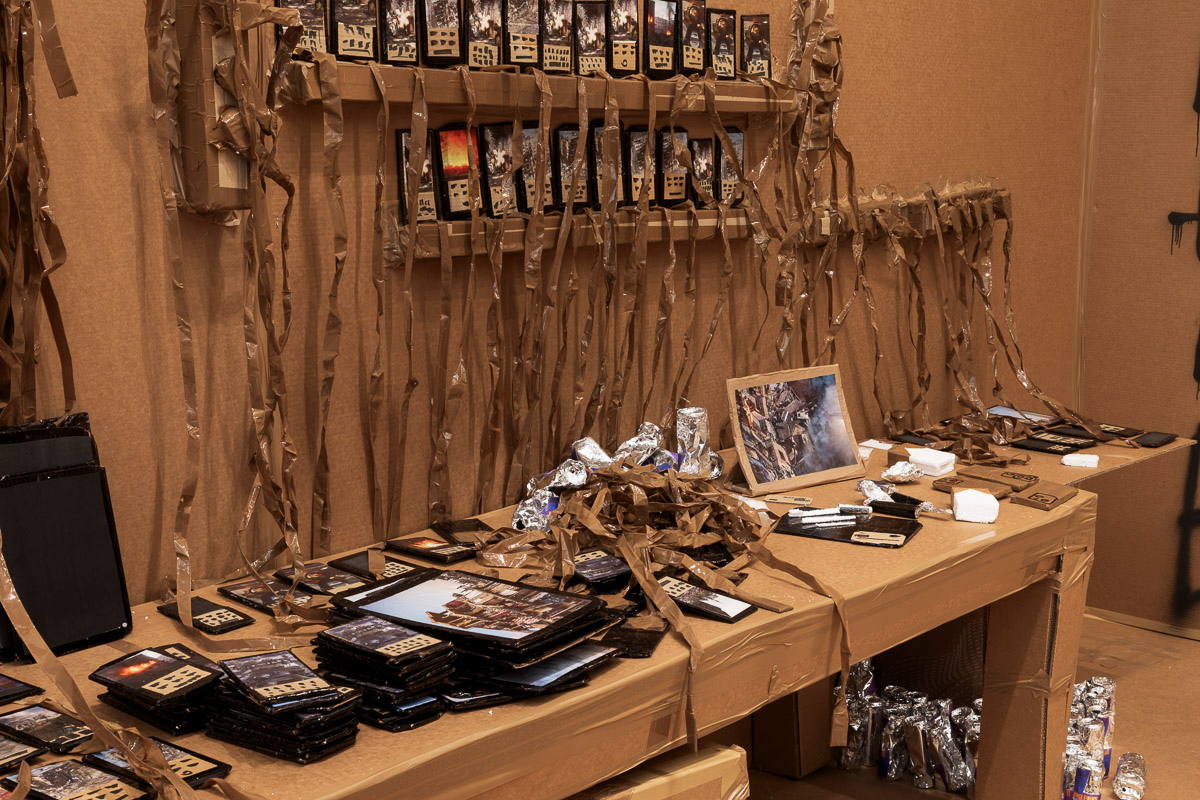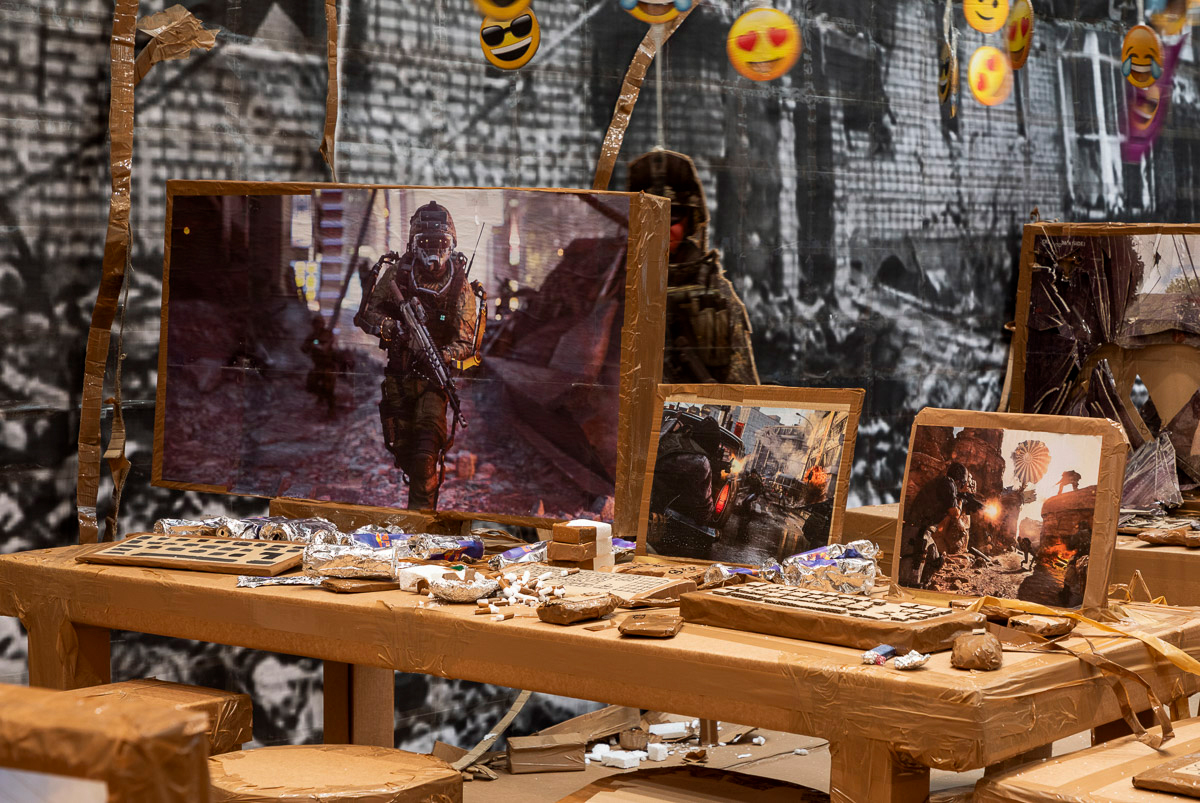 Alex Kitnick
Alex Kitnick
Our contemporary morass, constructed out of cardboard, tape, and foil.

Thomas Hirschhorn: Fake it, Fake it – till you Fake it., installation view. Courtesy the artist and Gladstone Gallery. © Thomas Hirschhorn / Artists Rights Society.
Thomas Hirschhorn: Fake it, Fake it – till you Fake it., Gladstone Gallery, 530 West Twenty-First Street, New York City, through March 2, 2024
• • •
Thomas Hirschhorn’s new installation at Gladstone looks something like a mash-up of a war room and a dorm room, made out of cardboard and Styrofoam, at 1:1 scale. The cavernous gallery is now a den of mass delusion, crammed with long rows of workstations outfitted with monitors depicting human destruction—mostly bombed buildings in Gaza and Ukraine—and frames from first-person-shooter video games. Gathered around each screen lies what might be called binge paraphernalia: smashed cans of Red Bull, credit cards and cocaine, lighters, Marlboro cigarettes, BlackBerrys, and I ❤️ NY mugs, all made out of supply closet staples, that ubiquitous cardboard and Styrofoam, along with aluminum foil, markers, and tape. Standees of camouflaged soldiers dot the room as if taking it by siege. Some have large emojis—crying, smiling, and cry-smiling—instead of human faces; many more emojis hang from the ceiling like a coming storm. An industrial fan blasting from the back corner adds to this feeling of inclement weather, threatening to render the ad hoc exhibition even more precarious (a favorite word of Hirschhorn’s) than it already is.

Thomas Hirschhorn, Fake it, Fake it – till you Fake it., 2023 (detail). Cardboard, prints, tape, polystyrene, and aluminum foil. Courtesy the artist and Gladstone Gallery. Photo: David Regen. © Thomas Hirschhorn / Artists Rights Society.
A self-described engaged artist, Hirschhorn often works in public space. He might be best known to New York audiences for the sprawling monument he devoted to the Italian Marxist philosopher Antonio Gramsci at the Forest Houses, in the South Bronx, in 2013—the final iteration in a global series of patchwork homages dedicated to iconoclastic thinkers, including Georges Bataille, Gilles Deleuze, and Baruch Spinoza, that served as platforms for pedagogical ventures. His is a kind of social sculpture—perhaps a relational aesthetic—that gets some of its energy from the spontaneity of the street, but Hirschhorn’s practice has long had a foot in the traditional spaces of art, as well, which he uses less as places for contemplation than self-enclosed worlds. I have a strong memory of an exhibition he staged at Gladstone in 2002, Cavemanman, a somewhat terrifying maze of packing tape, its crevices crammed with oversize volumes of political theory, which imagined the visitor as a philosophical spelunker. There was a sense of terror to that installation, as the Battle of Tora Bora, in Afghanistan, was still fresh in people’s minds, but also a thrill of illusion; the old parable of Plato’s cave, whose prisoners thought shadows were the real thing, seemed to be rebooted for a new age—after the epochs of Debord’s spectacle and Baudrillard’s simulacrum.

Thomas Hirschhorn, Fake it, Fake it – till you Fake it., 2023 (detail). Cardboard, prints, tape, polystyrene, and aluminum foil. Courtesy the artist and Gladstone Gallery. Photo: David Regen. © Thomas Hirschhorn / Artists Rights Society.
Thinking about these two exhibitions together, with over twenty years between them, makes clear Hirschhorn’s ongoing preoccupation with the atrocities of war, but the artist’s new work, which is mock-encouragingly titled Fake it, Fake it – till you Fake it., is not so much a place to go underground than a staging ground, or studio, for another world. When I looked at pictures later on a friend’s Instagram, I couldn’t quite tell if the emojis were native to the gallery space or if they had been added after “in post.” Echoes of Plato’s cave again—which is real? which is illusion?—but Hirschhorn seems less interested in reestablishing realities than in forging hybrid realms. Aren’t shadows real, too? And isn’t it the case that emojis don’t cover the real, but comprise it? Fake it is a kind of cracked-cave account of our own contemporary morass, in which images and things have equal force. It’s a heavy-handed allegory, for sure, but not wrong because of it. Hirschhorn’s work has always been marked by a refreshing lack of subtlety. Overflowing with ambition (and possibly hubris?), it’s direct in the extreme.

Thomas Hirschhorn: Fake it, Fake it – till you Fake it., installation view. Courtesy the artist and Gladstone Gallery. © Thomas Hirschhorn / Artists Rights Society.
Hirschhorn’s art likes to wrestle with the big questions (the real and the virtual, addiction and violence), and its difference is best seen when compared to work with similar ambitions. In the previous exhibition at Gladstone, the artist Ed Atkins debuted a sixeen-minute super hi-def video on a very large screen in which he appeared in the guise of his digital doppelgänger—he had been scanned and reconstituted, apparently with the aid of an iPhone strapped to his head—playing a contemporary piano composition “in great sadness.” What does pain look like in a digital age? and Is digital pain even real? the work asked—plaintively and portentously—without ever stopping to ask why we wouldn’t be equally suspicious, or equally credulous, of depictions of discomfort on film or video, or onstage. (Aren’t all of these performances of pain?) Hirschhorn is also interested in the strangeness of our moment, but rather than simply stare at it, he puts it to the test.

Thomas Hirschhorn, Fake it, Fake it – till you Fake it., 2023 (detail). Cardboard, prints, tape, polystyrene, and aluminum foil. Courtesy the artist and Gladstone Gallery. Photo: David Regen. © Thomas Hirschhorn / Artists Rights Society.
Not surprisingly, people have strong feelings about Hirschhorn’s art—and Hirschhorn has strong feelings about it, too. In fact, one might go so far as to say that he’s dedicated his entire practice to finding forms for feelings, figuring out how to convert love and ardor into physical presences. (One Hirschhorn origin story is that he was inspired by the makeshift shrines that sprung up across London following the death of Princess Diana—people’s monuments, to be sure, but also conditioned by the media’s fascination with this Marilyn-like celebrity.) Significantly, the artist has never used monumental materials, such as marble and bronze, though he could certainly access them if he so desired. Nor has he taken the bait of high tech. Rather, he stays close to fast, cheap, and leftover substances, typically cardboard and tape. And he uses these things like the German artist Joseph Beuys used felt and fat—to spread energy and affect. Thanks to Amazon, cardboard might be the truest material of distribution today, housing countless packages, and so it seems a fitting envelope for transporting news about new futures, too. (At the same time, it also maintains some of the street sense Claes Oldenburg found in it nearly seventy years ago.) Personally, I find Hirschhorn’s aesthetic choices fitting—at times, even profound—but I am also aware that many are irritated by his art, that they consider it condescending, “cringe,” didactic, self-conscious, willful, perhaps even undignified. And those reactions aren’t wrong. Hirschhorn’s art is an irritant, a shard in the eye. And that’s why it might help us see the world—and what we want from it—more clearly.
Alex Kitnick teaches art history at Bard College in Annandale-on-Hudson, New York.